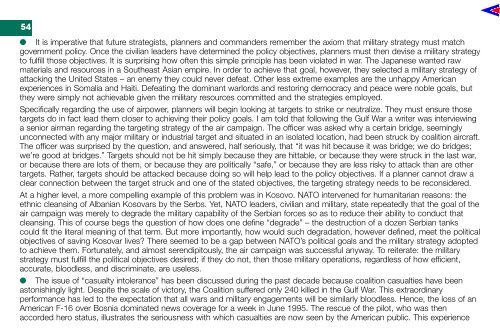THE RAF AIR POWER REVIEW - Royal Air Force Centre for Air ...
THE RAF AIR POWER REVIEW - Royal Air Force Centre for Air ...
THE RAF AIR POWER REVIEW - Royal Air Force Centre for Air ...
Create successful ePaper yourself
Turn your PDF publications into a flip-book with our unique Google optimized e-Paper software.
54<br />
● It is imperative that future strategists, planners and commanders remember the axiom that military strategy must match<br />
government policy. Once the civilian leaders have determined the policy objectives, planners must then devise a military strategy<br />
to fulfill those objectives. It is surprising how often this simple principle has been violated in war. The Japanese wanted raw<br />
materials and resources in a Southeast Asian empire. In order to achieve that goal, however, they selected a military strategy of<br />
attacking the United States – an enemy they could never defeat. Other less extreme examples are the unhappy American<br />
experiences in Somalia and Haiti. Defeating the dominant warlords and restoring democracy and peace were noble goals, but<br />
they were simply not achievable given the military resources committed and the strategies employed.<br />
Specifically regarding the use of airpower, planners will begin looking at targets to strike or neutralize. They must ensure those<br />
targets do in fact lead them closer to achieving their policy goals. I am told that following the Gulf War a writer was interviewing<br />
a senior airman regarding the targeting strategy of the air campaign. The officer was asked why a certain bridge, seemingly<br />
unconnected with any major military or industrial target and situated in an isolated location, had been struck by coalition aircraft.<br />
The officer was surprised by the question, and answered, half seriously, that “it was hit because it was bridge; we do bridges;<br />
we’re good at bridges.” Targets should not be hit simply because they are hittable, or because they were struck in the last war,<br />
or because there are lots of them, or because they are politically “safe,” or because they are less risky to attack than are other<br />
targets. Rather, targets should be attacked because doing so will help lead to the policy objectives. If a planner cannot draw a<br />
clear connection between the target struck and one of the stated objectives, the targeting strategy needs to be reconsidered.<br />
At a higher level, a more compelling example of this problem was in Kosovo. NATO intervened <strong>for</strong> humanitarian reasons: the<br />
ethnic cleansing of Albanian Kosovars by the Serbs. Yet, NATO leaders, civilian and military, state repeatedly that the goal of the<br />
air campaign was merely to degrade the military capability of the Serbian <strong>for</strong>ces so as to reduce their ability to conduct that<br />
cleansing. This of course begs the question of how does one define “degrade” – the destruction of a dozen Serbian tanks<br />
could fit the literal meaning of that term. But more importantly, how would such degradation, however defined, meet the political<br />
objectives of saving Kosovar lives? There seemed to be a gap between NATO’s political goals and the military strategy adopted<br />
to achieve them. Fortunately, and almost serendipitously, the air campaign was successful anyway. To reiterate: the military<br />
strategy must fulfill the political objectives desired; if they do not, then those military operations, regardless of how efficient,<br />
accurate, bloodless, and discriminate, are useless.<br />
● The issue of “casualty intolerance” has been discussed during the past decade because coalition casualties have been<br />
astonishingly light. Despite the scale of victory, the Coalition suffered only 240 killed in the Gulf War. This extraordinary<br />
per<strong>for</strong>mance has led to the expectation that all wars and military engagements will be similarly bloodless. Hence, the loss of an<br />
American F-16 over Bosnia dominated news coverage <strong>for</strong> a week in June 1995. The rescue of the pilot, who was then<br />
accorded hero status, illustrates the seriousness with which casualties are now seen by the American public. This experience

















